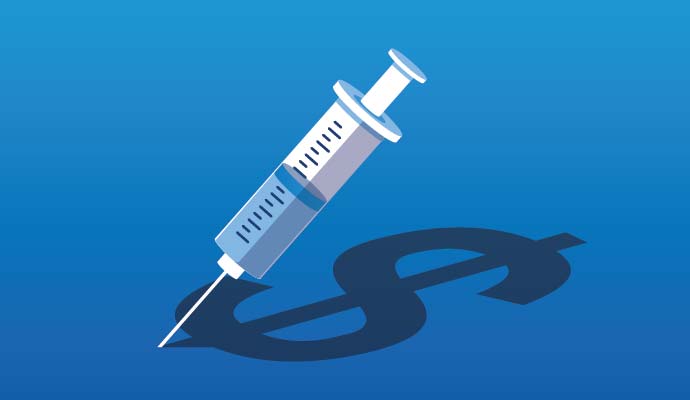Blue Cross Minnesota Announces $0 Insulin Copay, More Access to Care
The $0 copay for insulin, which will start in 2020, will improve access to care for commercial, fully-insured diabetic members.

Source: Getty
- Blue Cross and Blue Shield of Minnesota (Blue Cross) will offer a $0 insulin copay for commercial, fully-insured members, increasing diabetic members’ access to care, the payer announced.
“Our first responsibility is to do what we can to improve the health and financial stability of our members," said Craig Samitt, MD, president and chief executive officer of Blue Cross. "We felt a responsibility to address the skyrocketing cost of insulin with the options we have available. Hopefully, our action will provide some measure of financial relief to many of our members who live with diabetes."
Blue Cross will cover both Tier 1 and Tier 2 insulin medications for those who are under a commercial, fully insured plan. Self-insured employers can also select to offer this benefit to their employees.
The benefit will be applied automatically to qualifying members and employer groups on January 1, 2020. The change will have no effect on 2020 premiums.
Before Blue Cross can extend this benefit to its members, the state must give its approval.
READ MORE: BCBSAZ Tackles Medication Adherence Through Mobile Health
High insulin costs is a well-documented issue in the chronic disease management space.
On average, between 2012 and 2016 the point of sale price for insulin nearly doubled, according to a January 2019 report from the Health Care Cost Institute. Even when factoring in significant manufacturer rebates, the average net cost in 2016 would still be double what it was in 2012.
Although the net price paid to the manufacturer tends to be much lower than the list price, diabetic members still pay dearly for medications, the American Diabetes Association (ADA) found. Furthermore, prescribers seem to prefer more expensive, newer insulins.
In Minnesota, 7.8 percent of adults were diabetic in 2017 and one in ten did not know they were diabetic, the state’s department of health website reports. Minnesota had one of the highest prevalence of diagnosed diabetes in the nation.
It is well known that diabetics with financial barriers may ration or forego medications in order to cut their out-of-pocket costs. These practices can lead to devastating short- and long-term health consequences.
READ MORE: BCBSRI Program Aims to Lower Senior Adverse Drug Events by 20%
By reducing copays to $0, Blue Cross seeks to tackle financial barriers preventing access to care. However, representatives from Blue Cross also had critiques for the pharmaceutical industry, stating that it is responsible for high insulin prices.
“The problem is much larger than insulin," Samitt said. "More must be done to hold pharmaceutical companies accountable for the astronomical and arbitrary prices they set for medications that treat a range of serious and chronic issues. With no oversight or accountability, these companies will continue to charge whatever they want, with impunity.”
Sammit recognized the need for a collaborative effort to reduce high insulin costs.
“As a state, we need to work together and address the root causes of what is making affordable treatment out of reach for too many people."
To the ADA, the responsibility for high prescription drug prices lies at the feet of more than one player in the healthcare industry.
READ MORE: Price of Insulin Doubles, Increasing Spending for Members, Payers
After reviewing the status of insulin costs, the organization’s study resolved that payers, providers, and pharmacies would all need to make changes in their approach to insulin pricing.
Payers, the study recommended, should set cost-sharing at the lowest price possible.
Providers need to be more conscientious about their prescribing practices, ensuring that they are prescribing the insulin that fits into their patients’ price range.
Manufacturers should ensure that insulin list prices and net prices are the same or more similar. The ADA also suggested reducing rebates on the list price.
The ADA study concluded that payers, manufacturers, and pharmacy benefits managers (PBMs) should all adhere to formularies with a full range of insulin preparations priced at the lowest cost-sharing tier. They should seek to innovate effective insulation preparations and to increase transparency in the supply chain.
Other payers have also seen cost reductions through preventive measures. By catching members who are prediabetic, Cigna was able to employ a digital Diabetes Prevention Program that led to between $421 and $972 net medical cost reductions for members in the program. CVS Health’s recent expansion diabetic program included offering vouchers for hypertension diabetics its MinuteClinic to promote access to metabolic care.
While the announcement foregrounds these complex and controversial subtexts of drug pricing, Blue Cross’s new $0 copay policy could be a strong, needed step in the direction of reasonable insulin preparation pricing and greater access to care for diabetic members.
Other payers have decreased insulin pricing as well.
Cigna offers a month’s supply of insulin for a $25 copay through its PBM, Express Scripts. Sanofi produces a similarly-sized pack of insulin pens priced at $99. Lilly released a generic brand available at half the price of the brand-name version.
However, of these recent examples, Blue Cross’s approach stands out because it requires zero payment from the member.
While these measures strive for lower healthcare spending and reduced out-of-pocket costs, the dialogue surrounding this move reveals that the true answer lies in more long-term solutions.
